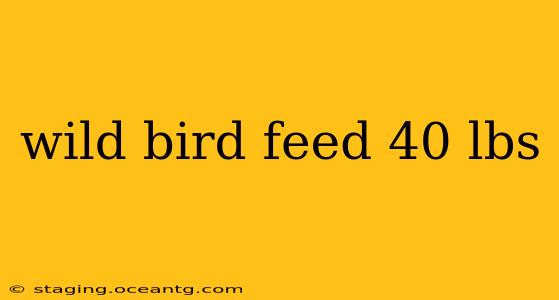Choosing the right bird feed can significantly impact the variety and number of birds visiting your backyard. A 40-lb bag of wild bird feed represents a substantial commitment, ensuring a consistent supply for your feathered friends throughout the seasons. This guide explores everything you need to know about purchasing, storing, and utilizing large quantities of wild bird seed, helping you attract a vibrant avian community to your space.
What are the Benefits of Buying Wild Bird Feed in 40 lb Bags?
Purchasing a 40-lb bag of wild bird feed offers several key advantages:
- Cost Savings: Buying in bulk generally translates to lower per-pound costs compared to smaller bags. This is a significant advantage for those who regularly feed birds.
- Convenience: Fewer trips to the store mean less time spent shopping and more time enjoying your birds.
- Consistent Supply: A large bag ensures you'll have enough feed to get you through periods of high bird activity or inclement weather.
What Types of Wild Bird Feed are Available in 40 lb Bags?
The market offers a wide variety of wild bird feed blends available in 40-lb bags. The most common include:
- Black Oil Sunflower Seeds: A popular choice because they are high in oil, attracting a broad range of birds.
- White Sunflower Seeds: Slightly smaller than black oil sunflower seeds, they are also a favorite among birds but are often more expensive.
- Mixed Seed Blends: These blends typically contain a combination of seeds, grains, and nuts, catering to a variety of bird species. Be aware that some lower-quality blends may contain fillers that birds won't eat.
- Nyjer (Thistle) Seed: This small seed is particularly attractive to finches and goldfinches. It's often sold separately and is more expensive than sunflower seeds.
- Suet: A high-energy food source, especially beneficial during colder months. Often sold in cakes or logs. While not commonly sold in 40lb bags, you can often find larger bulk sizes.
How Long Does 40 lbs of Wild Bird Feed Last?
The longevity of a 40-lb bag of bird feed depends on several factors:
- Number of Birds: A larger flock will consume the feed more quickly.
- Type of Feed: Higher-energy feeds, like suet, may be consumed faster than lower-energy blends.
- Storage: Proper storage protects the feed from moisture and pests, extending its lifespan.
How to Store 40 lbs of Wild Bird Feed?
Proper storage is crucial to prevent spoilage and infestation:
- Cool, Dry Place: Store the feed in a cool, dry, and well-ventilated area, away from direct sunlight and moisture.
- Airtight Container: Transferring the feed to an airtight container, like a large plastic bin with a tight-fitting lid, will help maintain freshness and prevent pests.
- Pest Control: Regularly check for signs of infestation (insects, rodents). If you find any, discard the affected feed immediately.
What are the Different Types of Wild Bird Feeders?
Choosing the right feeder is as important as selecting the right feed. The type of feeder you choose will influence which birds you attract. Consider:
- Tube Feeders: These feeders dispense seeds through small openings, keeping them dry and preventing larger birds from dominating the feeding area.
- Hopper Feeders: Larger capacity feeders that offer easy access to seed.
- Platform Feeders: Open feeders suitable for ground-feeding birds.
Where Can I Buy 40 lb Bags of Wild Bird Feed?
40-lb bags of wild bird feed are typically available at:
- Farm and feed stores: These stores often carry a wide variety of bulk bird feed options at competitive prices.
- Online retailers: Online retailers offer convenience and a wider selection but may have higher shipping costs.
- Wildlife supply stores: These stores specialize in wildlife products and may offer high-quality blends.
This guide provides a comprehensive overview of wild bird feed in 40-lb bags. Remember, responsible bird feeding involves providing high-quality food, storing it properly, and maintaining clean feeders. By following these guidelines, you can ensure a plentiful and enjoyable experience for both you and your feathered friends.
